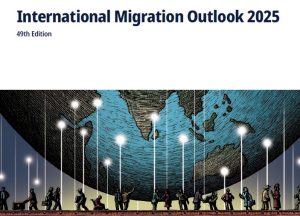Migration flows ease but remain historically high – OECD
Permanent migration to OECD countries declined by about four per cent in 2024 following three years of post-pandemic increases, according to a new report from the OECD.
But the total of 6.2 million new permanent immigrants remains nevertheless historically high –15 per cent above 2019 levels the, OECD’s ‘International Migration Outlook’ says.
 Family remained the leading reason for permanent migration to OECD countries. Labour migration declined by 21 per cent, after a sustained increase since 2020.
Family remained the leading reason for permanent migration to OECD countries. Labour migration declined by 21 per cent, after a sustained increase since 2020.
And humanitarian migration increased by 23 per cent due to the high number of asylum applications in preceding years and a record level of new resettled refugees, up 19 per cent.
Temporary labour migration stabilised in 2024 at a historically high-level with around 2.3 million work permits and authorisations granted.
“In 2024, OECD countries welcomed over 1.8 million international tertiary-education students, 13 per cent fewer than in 2023. This decline was primarily due to decreasing inflows to all top four receiving countries: United States, down 12 per cent; United Kingdom, down 14 per cent; Canada, down 39 per cent; and Australia, down 22 per cent,” the report says.
But the number of new asylum seekers in the OECD continued to increase (up 13 per cent) and was the highest on record, with 3 million new applications registered in 2024. The surge was driven by the United States, but increases were also recorded in Canada and the United Kingdom, while in the rest of the OECD the number of applications decreased.
“Detections of irregular border crossings at EU borders decreased rapidly in 2024 (down 37 per cent), as did Border Patrol encounters in the United States (down 48 per cent), while detections of attempts to enter the United Kingdom irregularly increased by 19 per cent. At the same time, returns from the EU, the United Kingdom and the United States increased steadily between 2021 and 2024,” the report says.
It also reveals a record level of labour market outcomes for migrants.
“Labour market outcomes for immigrants saw more mixed trends in 2024 as the employment rate of immigrants improved further in only half of OECD countries. On average, almost 77 per cent of immigrants were economically active, with almost 71 per cent employed and less than 10 per cent unemployed,” the report says.
It states that overall women migrants had better employment outcomes than men. In a third of OECD countries, immigrant women’s employment rates increased while men’s decreased, leading to some of the lowest gaps between men and women in years.
The report found national migration and integration policies among OECD countries are going through wholesale change.
It says a number of OECD countries have implemented objectives to reduce migration, either for overall migration or for specific categories. And labour migration policies are increasingly tailored to talent attraction and to meet specific labour market needs.
“Asylum systems have become more restrictive in many countries, with faster procedures, reduced benefits, and new limits on family reunification,” the report says.
In many countries, international student policies are under review, with some countries tightening admission and post-study rights, while others are enhancing retention pathways to support labour market integration.
The report says targeted support for migrant women is growing – recognition of skills is being streamlined, and the offer for bridging courses and micro-credential programs is being scaled up.
But immigrants continue to work in disproportionately in lower-paying jobs and sectors, it says.
The OECD data shows immigrants at entry level in the labour market earn 34 per cent less than native-born workers of the same age and sex and that two-thirds of this gap is due to immigrants working in lower-paying sectors and firms.
“The immigrant earnings gap decreases by about one-third in the first five years in the host country, and by about half in the first ten years. This is partly driven by immigrants moving to higher-paying sectors and firms,” the report says.
It recommends that policies that target barriers to job mobility should feature more prominently in the integration policy toolkit.
“This includes providing information on job search, career counselling and the development of professional networks, but also improving local transportation and access to affordable housing, among others,” the report says.
It says OECD health systems continue to rely heavily on migrant doctors and nurses with more than 830 000 foreign-born doctors and 1.75 million foreign-born nurses working in the OECD, representing about one-quarter and one-sixth of the workforce, respectively.
Among the report’s key findings are:
*In 2024, more than 160 million people living in OECD countries were foreign-born. Since 2014, the share of foreign-born rose from 9.1 per cent to 11.5 per cent.
*In most OECD countries, permanent migration declined in 2024 compared to 2023, especially EU countries.
*The number of new seasonal migrants and working holidaymakers increased in 2024, up 8 per cent and 4 per cent, respectively.
*The number of migrants participating in national temporary foreign worker programs decreased, down 7 per cent), after strong post-pandemic growth.
*In 2024 more than half of the three million asylum applications in the OECD were registered in the United States in 2024. Top origin countries of applicants included Venezuela, Colombia, Syria, Afghanistan and India.
Read the full report: https://www.oecd.org/en/publications/2025/11/international-migration-outlook-2025_355ae9fd.html












